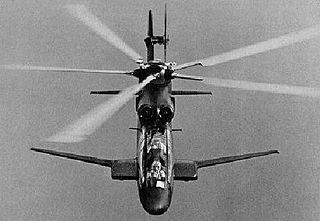
The Sikorsky UH-60 Black Hawk is a four-blade, twin-engine, medium-lift utility military helicopter manufactured by Sikorsky Aircraft. Sikorsky submitted the S-70 design for the United States Army's Utility Tactical Transport Aircraft System (UTTAS) competition in 1972. The Army designated the prototype as the YUH-60A and selected the Black Hawk as the winner of the program in 1976, after a fly-off competition with the Boeing Vertol YUH-61.
The CarterCopter is an experimental compound autogyro developed by Carter Aviation Technologies in the United States to demonstrate slowed rotor technology. On 17 June 2005, the CarterCopter became the first rotorcraft to achieve mu-1 (μ=1), an equal ratio of airspeed to rotor tip speed, but crashed on the next flight and has been inoperable since. It is being replaced by the Carter Personal Air Vehicle.

The Sikorsky S-67 Blackhawk was a private-venture, prototype attack helicopter built in 1970 with Sikorsky Aircraft research and development (R&D) funds. A tandem, two-seat aircraft designed around the dynamic drive and rotor systems of the Sikorsky S-61, it was designed to serve as an attack helicopter or to transport up to eight troops into combat.

The Boeing X-50A Dragonfly, formerly known as the Canard Rotor/Wing Demonstrator, was a VTOL rotor wing experimental unmanned aerial vehicle that was developed by Boeing and DARPA to demonstrate the principle that a helicopter's rotor could be stopped in flight and act as a fixed wing, enabling it to transition between fixed-wing and rotary-wing flight.

The Piasecki Aircraft Corporation (PiAC) is a manufacturer of aircraft, principally advanced rotorcraft. It was founded by American vertical flight pioneer Frank Piasecki to develop compound helicopters and other advanced rotorcraft after he was ousted from the leadership of his first company, Piasecki Helicopter.
A convertiplane is defined by the Fédération Aéronautique Internationale as an aircraft which uses rotor power for vertical takeoff and landing (VTOL) and converts to fixed-wing lift in normal flight. In the US it is further classified as a sub-type of powered lift. In popular usage it sometimes includes any aircraft that converts in flight to change its method of obtaining lift.

The Sikorsky S-72 was an experimental compound helicopter developed by helicopter manufacturer Sikorsky Aircraft.

The Sikorsky S-69 is an American experimental co-axial compound helicopter developed by Sikorsky Aircraft as the demonstrator of the Advancing Blade Concept (ABC) under United States Army and NASA funding.

The Boeing Vertol YUH-61 was a twin turbine-engined, medium-lift, military assault/utility helicopter. The YUH-61 was the runner-up in the United States Army Utility Tactical Transport Aircraft System (UTTAS) competition in the early 1970s to replace the Bell UH-1 Iroquois helicopter. At the end of the flyoff program, Sikorsky Aircraft was awarded a contract to develop and build its UH-60A entry.

The Sikorsky X2 is an experimental high-speed compound helicopter with coaxial rotors developed by Sikorsky Aircraft.

The Fairey FB-1 Gyrodyne is an experimental British rotorcraft that used single lifting rotor and a tractor propeller mounted on the tip of the starboard stub wing to provide both propulsion and anti-torque reaction.

The slowed rotor principle is used in the design of some helicopters. On a conventional helicopter the rotational speed of the rotor is constant; reducing it at lower flight speeds can reduce fuel consumption and enable the aircraft to fly more economically. In the compound helicopter and related aircraft configurations such as the gyrodyne and winged autogyro, reducing the rotational speed of the rotor and offloading part of its lift to a fixed wing reduces drag, enabling the aircraft to fly faster.

The Eurocopter X³(X-Cubed) is an experimental high-speed compound helicopter developed by Airbus Helicopters. A technology demonstration platform for "high-speed, long-range hybrid helicopter" or H³ concept, the X³ achieved 255 knots in level flight on 7 June 2013, setting an unofficial helicopter speed record. In June 2014, it was placed in a French air museum in the village of Saint-Victoret.

The Sikorsky S-97 Raider is a high-speed scout and attack compound helicopter based on the Advancing Blade Concept (ABC) with a coaxial rotor system under development by Sikorsky Aircraft. Sikorsky planned to offer it for the United States Army's Armed Aerial Scout program, along with other possible uses. The S-97 made its maiden flight on 22 May 2015.

Future Vertical Lift (FVL) is a plan to develop a family of military helicopters for the United States Armed Forces. Five different sizes of aircraft are to be developed, sharing common hardware such as sensors, avionics, engines, and countermeasures. The U.S. Army has been considering the program since 2004. FVL is meant to develop replacements for the Army's UH-60 Black Hawk, AH-64 Apache, CH-47 Chinook, and OH-58 Kiowa helicopters. The precursor for FVL is the Joint Multi-Role (JMR) helicopter program.

The Bell V-280 Valor is a tiltrotor aircraft being developed by Bell and Lockheed Martin for the United States Army's Future Vertical Lift (FVL) program. The aircraft was officially unveiled at the 2013 Army Aviation Association of America's (AAAA) Annual Professional Forum and Exposition in Fort Worth, Texas. The V-280 made its first flight on 18 December 2017 in Amarillo, Texas.

The Vertical Take-Off and Landing Experimental Aircraft program is an American research project sponsored by the Defense Advanced Research Projects Agency (DARPA). The goal of the program is to demonstrate a VTOL aircraft design that can take off vertically and efficiently hover, while flying faster than conventional rotorcraft. There have been many previous attempts, most of them unsuccessful.

The Sikorsky–Boeing SB-1 Defiant is the Sikorsky Aircraft and Boeing entry for the United States Army's Future Vertical Lift program, succeeding the Joint Multi-Role (JMR) initiative. It is a compound helicopter with rigid coaxial rotors, powered by two Honeywell T55 turboshaft engines; it first flew on 21 March 2019.

The Airbus RACER is an experimental high-speed compound helicopter developed by Airbus Helicopters from the Eurocopter X³. Revealed at the June 2017 Paris air show, final assembly will start in mid-2020 for a 2021 first flight. Cruising up to 400 km/h (216 kn), it aims for a 25% cost reduction per distance over a conventional helicopter.


















